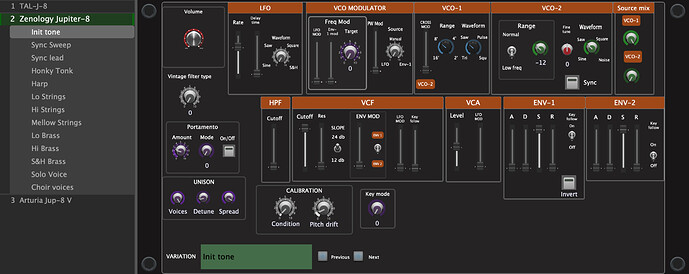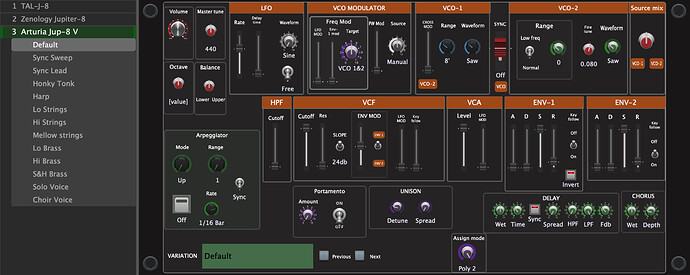My second “exercise” on panel-design was replicating the layout of another favorite from TAL: their Jupiter-8.
This synth is a little bit more sophisticated compared to the Juno 60 and fitting everything essential on one panel required some creative choices. To make the arpeggiator smaller and more accessible with widgets, the oh-so-iconic colorful radio-buttons had to go, being replaced with 4 knobs. Yet I tried to be faithful to TAL’s design since I’m very used to creating patches with their layout.
Also this time I did everything on my 13" Macbook, since that’s the screen I use while gigging. You can increase the font sizes if you wish to work on a much bigger screen.
Since Jupiter-8 is a multitimbral synth, I decided to add another panel below the first one just to control the lower part of the synth if needed.
Variations act as patch memory and I included some of the classic factory patches of Jupiter to get you started.
But wait! There is more!
Since I’ve recently started gigging with Roland’s Fantom-07 and using their Jupiter-8 model expansion a lot, I also decided to tweak my original panel a little bit in order to control that same model expansion on their Zenology plug-in synth. This allows me to design sounds with just my laptop using the familiar TAL-layout and then export the sounds from Zenology to the hardware Fantom. Very handy.
There are a couple of minor differences as can be seen on the screenshot: the calibration section is more limited in Zenology and the built-in effects like delay or chorus cannot be controlled via widgets (as far as I know). Zenology also omitted the arpeggiator, thus having it on the panel wasn’t necessary. But then again: the original Jupiter didn’t come with any built-in effects, so leaving the junoesque chorus buttons out kind of makes it more “authentic”.
And yet another extra:
Designing the above panels allowed me to do some quick and easy comparisons between the two emulations of the same synth. So why not expand the idea further and bring in Arturia’s Jup-8 V, propably the oldest Jupiter-clone of the bunch! And their fully functional demo was free to download!
Again a couple of minor tweaks were required to match the functionality of Arturia’s product, but this time the end result was much closer to TAL’s panel.
Some of you might be now asking what is the end result of my comparison? Which of the three synths is best? My very subjective quick opinion: they all sound very, very good and judging on just the sound, I could happily use any of these three.
But since there are other factors to consider, my personal favorite stays the same: if you’re out looking for the best Jupiter-8 plugin on the market, I highly recommend you to choose TAL-j-8. I’ll give you three reasons:
-
CPU load: on my early-2015 MBP, the CPU meter of Gig Performer reads 2% when not playing anything on the J-8. Zenology climbs up to 8-10% and Arturia moves between 7-9%. And this is without playing a single note.
-
The GUI is amazingly clear for all kinds of screens. I like how it’s easily scalable with just dragging and TAL’s choice of dividing the main panel (VCO’s, Envelopes and Filter) on two rows simply works on small screens much better than Arturia’s “true to the original” approach. Arturia HAS improved their scalability and overall layout with the V4 of this synth (the first versions were a total nightmare and for me pretty much unusable on a laptop), but I think TAL still wins easily. Roland on the other hand wish to keep the basic style of all their Zenology-powered synths similar in. I do like seeing graphical representations of the envelopes but otherwise, the layout of Zenology doesn’t feel as approachable for me as TAL’s synths.
-
It is the cheapest of the bunch! Yeah, you can get Arturia’s products with discount prices lower than TAL’s every once in a while, but TAL’s stuff usually stays consistently affordable. The main reason for choosing Jup-8 V would propably be owning it as a part of Arturia V-Collection. If you’re in to that, definitely wait for their next discount campaign.
Jupiter-8 Rackspace.gig (8.0 MB)


